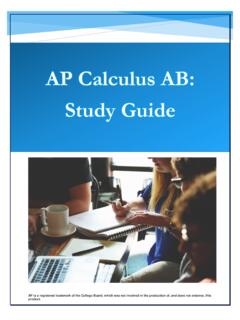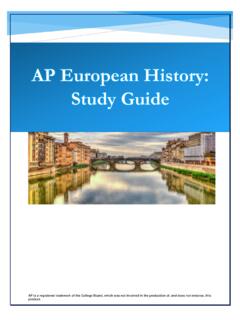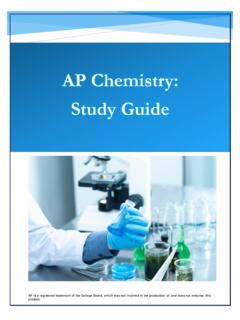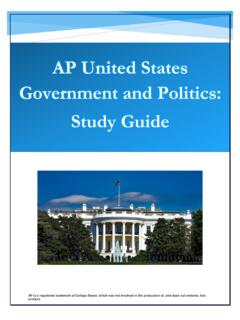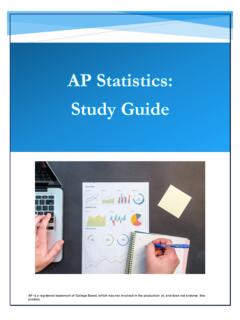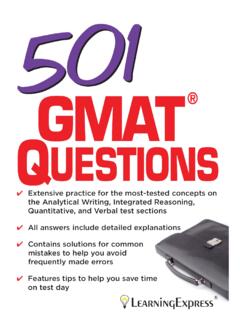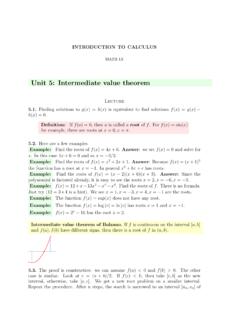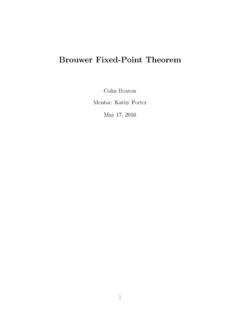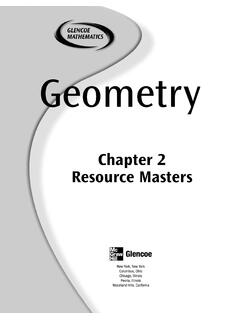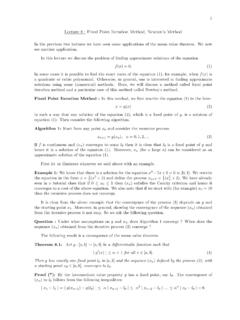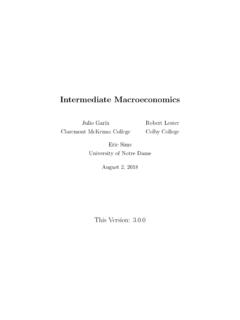Transcription of AP Calculus BC Study Guide - EBSCO Information Services
1 AP Calculus BC: Study Guide AP is a registered trademark of the College Board, which was not involved in the production of, and does not endorse, this product. Key Exam Details The AP Calculus BC exam is a 3-hour 15-minute, end-of-course test comprised of 45 multiple-choice questions (50% of the exam) and 6 free-response questions (50% of the exam). The exam covers the following course content categories: Limits and Continuity: 4 7% of test questions Differentiation: Definition and Fundamental Properties: 4 7% of test questions Differentiation: Composite, Implicit, and Inverse Functions 4 7% of test questions Contextual Applications of Differentiation: 6 9% of test questions Analytical Applications of Differentiation: 8 11% of test questions Integration and Accumulation of Change: 17 20% of test questions Differential Equations: 6 9% of test questions Applications of Integration: 6 9% of test questions Parametric Equations, Polar Coordinates, and Vector-Valued Functions: 11 12% of test questions Infinite Sequences and Series.
2 17 18% of test questions This Guide offers an overview of the main tested subjects, along with sample AP multiple-choice questions that look like the questions you ll see on test day. Limits and Continuity About 4 7% of the questions on your exam will cover Limits and Continuity. Limits The limit of a function f as x approaches c is L if the value of f can be made arbitrarily close to L x sufficiently close to c (but not equal to c). If such a value exists, this is denoted . If no such value exists, we say that the limit does not exist, abbreviated DNE. Limits can be found using tables, graphs, and algebra. Important algebraic techniques for finding limits include factoring and rationalizing radical expressions. Other helpful tools are given by the following properties. , and a is any real number. by taking lim()xcf xL =Suppose lim()xcf xL =, lim()xcg xM =, lim()xLh xN =1 Then: )l)im((xcf xg xL M += + )l)im((xcf xg xL M = lim( )xcaLaf x = ()lim()xcf xLg xM =, as long as 0M ( )lim( )xcNh f x =For many common functions, evaluating limits requires nothing more than evaluating the function at the point c (assuming the function is defined at the point).
3 These include polynomial, rational, exponential, logarithmic, and trigonometric functions. Two special limits that are important in Calculus are 0sinlim1xxx =and 01 coslim0xxx =. One-Sided Limits Sometimes we are interested in the value that a function f approaches as x approaches c from only a single direction. If the values of f get arbitrarily close to L as x approaches c while taking on values greater than c, we say lim()xcf xL+ =. Similarly, if x is taking on values less than c, we write . lim()xcf xL =We can now characterize limits by saying that lim ( )xcfx exists if and only if both lim ( )xcfx+ and lim ( )xcfx exist and have the same value . A limit, then, can fail to exist in a few ways: does not exist lim ( )xcfx+ does not exist lim ( )xcfx Both of the one-sided limits exist, but have different values 2 Example The function shown has the following limits: 21l()imxfx = 21li()mxfx+ = 2)li(mxfx DNE 14l()imxfx = 14l()imxfx+ = 14l()imxfx =Note that f(1) = 3, but this is irrelevant to the value of the limit.
4 Infinite Limits, Limits at Infinity, and Asymptotes When a function has a vertical asymptote at x = c, the behavior of the function can be described using infinite limits. If the function values increase as they approach the asymptote, we say the limit is , whereas if the values decrease as they approach the asymptote, the limit is - . It is important to realize that these limits do not exist in the same sense that we described earlier; rather, saying that a limit is is simply a convenient way to describe the behavior of the function approaching the point. We can also extend limits by considering how the function behaves as x . If such a limit exists, it means that the function ()limxf xL =approaches a horizontal line as x increases yL=or decreases without bound. In other words, if , then f has a horizontal asymptote . It is possible for a function to have two horizontal asymptotes since it can have different limits as x and x.
5 3 The Squeeze theorem The Squeeze theorem states that if the graph of a function lies between the graphs of two other functions, and if the two other functions share a limit at a certain point, then the function in between also shares that same limit. More formally, if )(()()g xxfhx for all x in some interval containing c, and if lim ( ) lim ( )xcxcf xh xL ==, then lim ( )xcg xL =as well. Example The sine function satisfies sin11x for all real numbers x, so 111sinx is also true for all real numbers x. Multiplying this inequality by 2x, we obtain 2221sinxxxx . Now the functions on the left and right of the inequality, 2xand 2x , both have limits of 0 as 0x . Therefore, we can conclude that 201limsin0xxx = also.
6 Continuity The function f is said to be continuous at the point xc=if it meets the following criteria: 1. ()fcexists 2. )lim (xcfx exists 3. ( )( )limxcf xf c =In other words, the function must have a limit at c, and the limit must be the actual value of the function. Each of the above criteria can fail, resulting in a discontinuity at x = c. Consider the following three graphs: 4 In graph A, the function is not defined at c. In graph B, the function is defined at c, but the limit as xc does not exist due to the one-sided limits being different. In graph C, the function is defined at c and the limit as xc exists, but they are not equal to each other.
7 The discontinuity in graph B is referred to as a jump discontinuity, since it is caused by the graph jumping when it reaches x = c. In contrast to this is the situation in graph C, where the discontinuity could be fixed by moving a single point; it occurs whenever the second condition above is satisfied and is called a removable discontinuity. If lim ( )xcfx exists, but f has a discontinuity at x = c because it fails one of the other conditions, the discontinuity can be removed by defining or redefining f(c) to be equal to the limit at that point. A function is continuous on an interval if it is continuous at every point in the interval. The following categories of functions are continuous at every point in their respective domains: Polynomial Rational Power Exponential Logarithmic Trigonometric If f is a piecewise-defined function with continuous component functions, then checking for continuity consists of checking whether it is continuous at its boundary points.
8 Continuity at a boundary point requires that the functions on both sides of the point give the same result when evaluated at the point. intermediate value theorem The intermediate value theorem applies to continuous functions on an interval ,ab. If d is any value between f(a) and f(b), then there must be at least one number c between a and b such that f(c) = d. Example Consider 2()xf xe =, which is continuous everywhere. We have 021(0)fe= = , and f(1) = e 2, which is certainly positive. If we take 0d=in the statement of the theorem , then d is between f(0) and f(1). Therefore, the intermediate ( ) 0fc= value theorem guarantees ln 2c=at least one value c between 0 and 1 with the property that . This value , of course, is . 5 Suggested Reading Hughes-Hallett, et al.
9 Calculus : Single Variable. 7th edition. Chapter 1. New York, NY: Wiley. Larson & Edwards. Calculus of a Single Variable: Early Transcendental Functions. 7th edition. Chapter 2. Boston, MA: Cengage Learning. Stewart, et al. Single Variable Calculus . 9th edition. Chapter 2. Boston, MA: Cengage Learning. Rogawski, et al. Calculus : Early Transcendentals Single Variable. 4th edition. Chapter 2. New York, NY: Macmillan. Sullivan & Miranda. Calculus : Early Transcendentals. 2nd Edition. Chapter 1. New York, NY: Freeman. Sample Limits and Continuity Questions Consider the following graphs of f and g: Compute 2lim 3 ( )( )xf xg x+ , provided the limit exists. A. Does not exist B. 4 C. 6 D. 7 Explanation: The correct answer is D. First, use linearity to write: 222lim 3 ( )( )3 lim( )lim ( )xxxf xg xf xg x+++ = . 6.
10 Substituting these values above yields . Now, observe that 22lim( ) 3 and lim ( ) 2xxf xg x++ == 222lim 3 ( )( )3 lim( )lim ( ) 3(3) 2 7xxxf xg xf xg x+++ = = =Suppose that ( )3( )2 cosf xx =and the graph of g(x) is given by Compute 3lim( )( )xf x g x , provided it exists. A. 6 B. 4 C. 6 D. Does not exist Explanation: The correct answer is C. Use the fact that the limit of a product is the product of the limits, provided they both exist independently, to compute: () ()()()( )( )()( )( )( )3333lim( )( )lim( )lim ( )2 cos( 3)32 cos3236xxxf x g xf xg x = = = = =Which of the following limits does not exist? 7 A. B. C. D. sinlimxxx 1|1|lim1xxx 230limxx+ lim secxx Explanation: The correct answer is B. Recall that So, 1,1|1 |1,1xxxxx = 1,1|1 |1,11xxxx = Hence, 1|1|lim11xxx+ = while 1|1|lim11xxx =.
